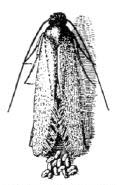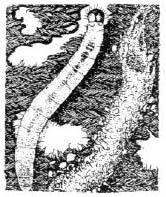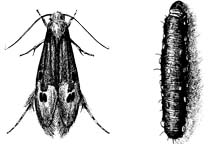Clothes Moths : Education Fact Sheet from Ohio State
Clothes Moths
HYG-2107-97
William F. Lyon
| Common Name | Scientific Name |
|---|---|
| Webbing Clothes Moth | Tineola bisselliella (Hummel) |
| Casemaking Clothes Moth | Tinea pellionella (Linnaeus) |
| Carpet or Tapestry Moth | Trichophaga tapetzella (Linnaeus) |
Clothes moth larvae feed on wool, feathers, fur, hair, leather, lint, dust, paper, and occasionally cotton, linen, silk, and synthetic fibers. They are especially damaging to fabric stained with beverages, urine, oil from hair, and sweat. Most damage is done to articles left undisturbed for a long time, such as old military uniforms and blankets, wool upholstery, feathered hats, antique dolls and toys, natural bristle brushes, weavings, wall hangings, piano felts, old furs, and especially wool carpets under heavy furniture and clothing in storage.
Damaged fabrics have holes eaten through them by small, white larvae and often have silken cases, lines of silken threads, and fecal pellets over the surface of the materials. Moths are destructive during the larvae stage. Adult "millers" or moths are entirely harmless.
Identification
Adult webbing clothes moths have a wingspread of about 1/2-inch. The body is about 1/4-inch long with wings folded and golden-yellow with a satiny sheen. A tuft of hairs on the head is upright and reddish-gold. Eggs are oval, ivory, and about 1/24-inch long. Larvae are a shiny, creamy white with a brown head, up to 1/2-inch long. The larvae spin long threads and construct tunnels of silk.

|

|
| Webbing Clothes Moth and Eggs | Webbing Clothes Moth: Larva and Larva Damage |
|---|
Adult casemaking clothes moths have a 1/2-inch wingspread. Forewings are yellowish-brown, and there are usually three distinct, dark dots on the outer third of each wing. Hind wings are smaller, lighter, and fringed with hair and scales. Eggs are whitish, and larvae are opaque-white with brown heads. The larva spins a small silken case around itself and carries it while feeding.

|
| Casemaking Clothes Moth: Adult and Larva |
|---|
Adult carpet or tapestry moths are larger than webbing or casemaking clothes moths at 1/3- to 5/12-inch long with a 3/4-inch wingspread. Adults have white heads, with the first third of the front wings black and the lower two-thirds creamy white. Hind wings are pale gray. Larvae are small, creamy white caterpillars with dark heads.
Life Cycle and Habits
Clothes moths rarely fly to lights at night and instead prefer darkness, such as a closet or storage chest. Any clothes moths fluttering around the house are probably males, because females travel by either running, hopping, or trying to hide in the folds of clothing. female webbing clothes moths lay 40 to 50 eggs that hatch in 4 to 21 days. Larvae like to feed on soiled material, spinning silken mats or tunnels and incorporating textile fragments and bits of fecal pellets. Larvae will wander some distance away from their food source to pupate in crevices. The pupa case is silken with bits of fiber and excrement attached to the outside. The life cycle is about 65 to 90 days.
The casemaking clothes moth is less common than the webbing clothes moth. Larvae spin a small silken case around themselves as they feed. This cigar-shaped case enlarges as the larva grows. When crawling, the larva's head, thorax, and three pairs of legs, outside the case, drag it along. It does not spin a web of silk over the food material but eats clean-cut holes, not usually in one spot. females live about 30 days and lay 100 to 300 eggs. The larva stage lasts 50 or more days, and the pupal stage is passed in the case or cocoon. There are about 2 generations a year.
Adult carpet or tapestry moths are rarely found. females lay 50 to 100 eggs in a lifetime, and the larva develops in about 3 months as it builds silken tubes or burrows through infested materials, such as hair-stuffed furniture, tapestries, old carpets, furs, and feathers.
Clothes moth development is greatly influenced by humidity. About 75-percent relative humidity in a heated, dark room is ideal.
Control Measures
Inspection
Locate the source of infestation before treatment. Examine closets and stored goods for larvae cases, moths, and damage. Larvae prefer to feed in secluded, dark places. Use a flashlight and nail file to check for woolen lint and hair under baseboards, in and under seldom moved upholstered furniture, in air ducts, in carpets at the corners of the room and along edges, in stored clothing, and in other places not readily accessible. Check furs or feathers, such as stuffed birds or animal heads, antique feather beds, or felt in pianos, woolen scrap piles, etc. Adult moths do not feed in fabrics, but may be seen in darkened corners at night.
A new pheromone for the webbing clothes moth is available through Insects Limited Inc., 1-800-992-1991 or 317-846-3399, fax: 317-846-9799.
Prevention
Good housekeeping is critical for preventing or controlling clothes moth damage. Never allow clothing, rugs, etc. to lie in a neglected pile. Regular use of a strong suction vacuum cleaner with a crevice tool to remove lint, hair, and dust from floor cracks, baseboards, air ducts, carpets, and upholstered furniture is necessary. Keep closets and dresser drawers clean. Regularly clean rugs where they fit close to the baseboards and under the quarter round. Inspect stored foods and eliminate bird nests and dead rodents. Launder and dry clean or steam clean clothes and other items before storage. Egg-laying clothes moths are attracted to soiled articles. Ironing will also destroy all stages of clothes moths. Sun, brush, and expose clothing to the weather. Outdoors, bright, hot sunlight, and wind will reduce larvae and damage. Frequent use of woolens and other animal fiber clothing almost assures no damage from clothes moth larvae.
Cedar-lined chests and closets are not 100 percent effective. The natural cedar oil evaporates and a fresh treatment of cedar oil should be applied every two years. Be sure that all cloth goods be dry cleaned, washed, pressed with a hot iron, sunned, or brushed prior to storage in an airtight container with an effective moth repellent.
Constant light illumination in the closet may discourage moths. Use tight-fitting doors. Try suspending wall to floor cotton drapes in front of clothing to keep dust and moths away. Fur storage in cold vaults is effective. Moth-proofing when woolens are manufactured may be effective forever, whereas treatments at dry cleaners are less permanent and need to be renewed regularly.
Freezing has been successfully used to control clothes moths. Place fabric in polyethylene bags, squeeze all air out to minimize condensation, and deep freeze the materials for three days. Infested antique objects should be either fumigated or deep frozen by an experienced licensed pest control operator.
Insecticides
It is best not to treat clothing with insecticides due to possible damage to the garments. All cracks and crevices in infested areas should be treated with a residual insecticide. After thoroughly cleaning rugs, rug pads, under heavy furniture, and carpets, especially around the edges, dust with bendiocarb (Ficam D) under the edges of carpeting, cracks in closets, under baseboard, and molding or other hiding places. Any wall void that might contain old rodent, bird, or insect nests should be drilled and dusted.
Sprays of pyrethrins (Exciter, Kicker, Pyrenone) and permethrin can be
used as spot treatments to kill any moths that might alight or wandering
larvae. Do not treat clothing. The licensed pest control operator or applicator
can use sprays of bendiocarb (Ficam W), bendiocarb + pyrethrins (Ficam Plus),
cyfluthrin (Tempo), or tralomethrin (Saga) in such places. Infested stuffed
furniture and other salvageable commodities should be fumigated by a licensed
pest control operator or applicator. Before using any insecticides, always
read the label directions and follow safety precautions.
The information found on the pages in this section are provided by Ohio State University for educational purposes. Apparel Search is not associated in anyway with Ohio State University. Apparel Search is simply providing viewers of the fashion industry with easy access to the helpful educational material that has been developed by Ohio State University. Please visit the Ohio State University web site to learn more about the wonderful educational opportunities that they provide.
Apparel
Search Add Your Company
Contact Us
About Us
Advertise
News Letter
Legal
Help
Copyright © 1999-2023 Apparel Search Company. All Rights Reserved.